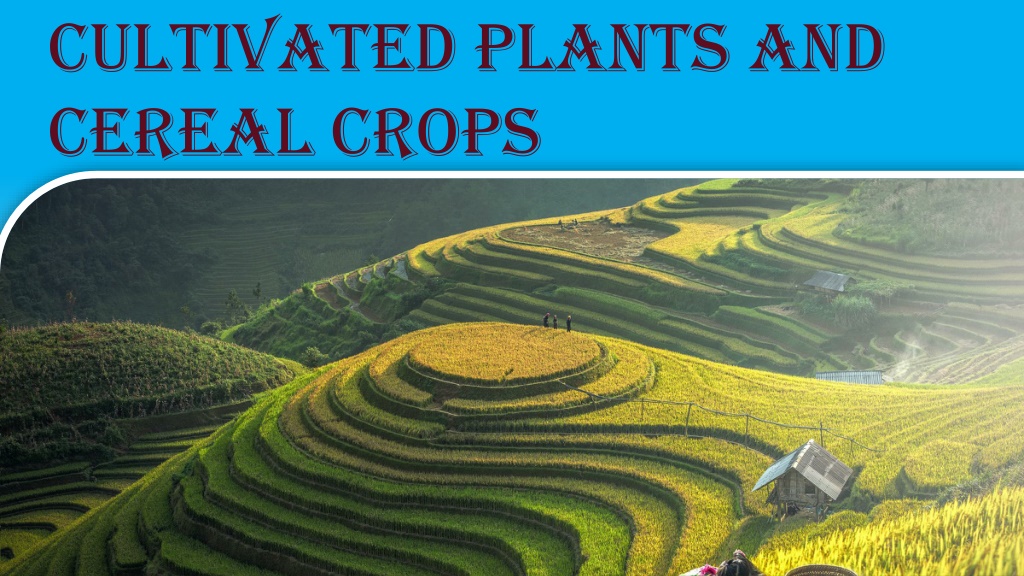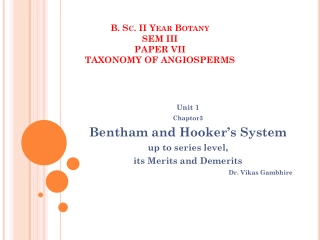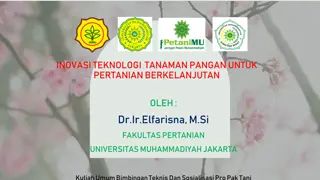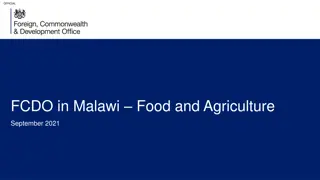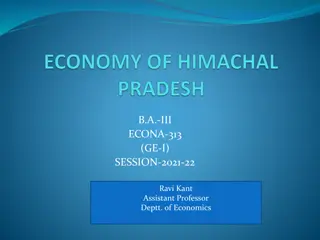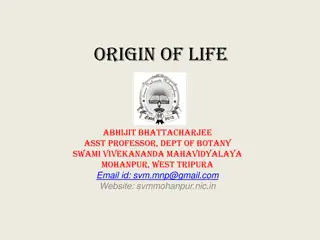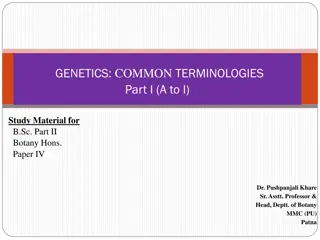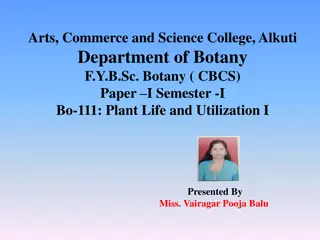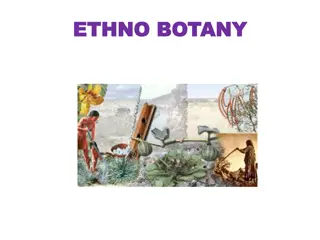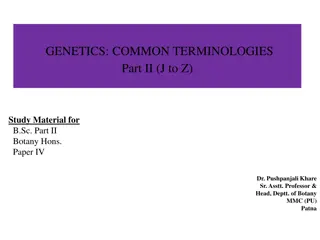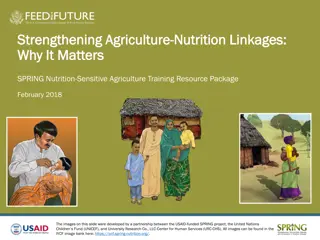Agriculture and Economic Botany Overview
Explore the world of cultivated plants and cereal crops, diving into the branches of economic botany such as agriculture, horticulture, forestry, and more. Learn about crop classification, including based on growing season, use, and economic importance. Discover the pioneers of crop production like Dr. Norman Borlaug and Dr. M.S. Swaminathan, and the significance of Nikolai Vavilov in identifying the centers of origin in cultivated plants.
Download Presentation

Please find below an Image/Link to download the presentation.
The content on the website is provided AS IS for your information and personal use only. It may not be sold, licensed, or shared on other websites without obtaining consent from the author. Download presentation by click this link. If you encounter any issues during the download, it is possible that the publisher has removed the file from their server.
E N D
Presentation Transcript
Cultivated plants and cereal crops
BRACHES OF ECONOMIC BOTANY BRACHES OF ECONOMIC BOTANY 1. Economic botany is a branch of botany that deals with the commercial exploitation of plants by people, in simple words, it is the intraction of people with plants. Branches of economic botany : 1. Agriculture 2. Horticulture 3. Forestry 4. Plant breeding 5. Pharmcolnogy 6. Plant pathology
CLASSIFICATION OF CROP PLANTS: Classification of crop plants 1. Classification based on growing season: Kharif, Rainy season or Moonsoon crops are grown in monsoon months from June to October, examples:- Maize, Rice, Cotton, Jower, Bajra etc. Rabi, winter or cold season crops are growns in winter season from October to March e.g. Whaet, Gram, sunflower etc. Summer or zaid crops are grown in summer month from March to June e.g. Watermelon, pumpkin, gourds etc.
CLASSIFICATION BASED ON USE 1. Grains crop Rice, Wheat, Maize, Barley, Jowas etc. 2. Pulses or legumes crops green gram 3. Vegetables crops ladyfinger, beans, brinjal, tomato etc. 4. Sugar crops Sugarcane, Sugarbeet etc. 5. Roots crops potato, yam etc.
CLASSIFICATION BASED ON ECONOMIC IMPORTANCE 1. Cash crop :- These crops are grown for earning money e.g. sugarcane, cotton etc. 2. Food crops :- These crops are grown food for humans and fodder for cattle e.g. Wheat, Rice, Maize, Jowas etc.
CROP PRODUCTION 1. Dr. Morman Ernest Borlaug is the father of Green Revolution and winner of Nobel peace Prize in 1970. 2. Dr. Mankombu Sambasivan Swaminathan is the father of Green Revolution in India. 3. Crop production in india is shown with the help of chart
1. Nikolai Ivanovich Vavilov was a prominent Russian and Soviet botanist and genetified best known for having idenrified the centres of origin in cultivated plants. 2. He Devoted his life to the study and improvement of wheat , corn, and other cereal crops that sustain the global population
CENTER OF ORIGIN CENTER OF ORIGIN
VAVILOV EIGHT CENTRE OF ORIGIN 1. Chinese center 2. Indian centre 3. Asiatic centre 4. Near eastern centre 5. Mediterranean centre 6. Assyinian centre 7. South Mexican and centre American centre 8. South American centre
(I). CHINESE CENTRE 1. The largest independent centre which includes the mountainous regions of central and western china, and adjacent lowlands. 2. A total of 36 endmic plants are listed, among which are few knows to us as important crop. 3. Cereals :- Asian rice, proso and fextail millet, Italian millet 4. Pulses :- Soybean, adzukl bean 5. Root and tuber crops :- Turnip, yams 6. Oil crops :- rape seed 7. Fruit & nuts :- chinese hickory, chestnut, persimmom, litchi, apricot, peach 8. Vegetables & spices :- chinese cabbage, ginger 9. Stimulants :- Tea, ginseng, campor
(II) NDIAN CENTREA This area has two subcentres. 1. Main Centre(Himdustan) : Includes Assam and Burma, but not Northwest India, Panjab, nor Northwest Frontier provinces. In this area, 117 plants were considered to be endemic. 1. Indo Malayan Centre :- Includes Indo- China and the Malay Archipelago. Fifty-five plant were listed, including.
1. Ceora Asian rice 2. Pulses Pigeon pea, jack bean, winged bean, Moth bean, rice bean. 3. Roots & tubers Yams, arrowroot, taro. 4. Oil crops cocnut 5. Fruit & nuts bread fruit, orange, banana 6. Vegetables & spices Cucumber, eggplant 7. Fibre plants Coconut, jute
(III) CENTRAL ASIATIC CENTRE 1. Include, Northwest india ( Punjab, Northwest Frontier Provinces and kashmir), Afghanistan, Tadjikistan, Uzbekistan, and Western Tain shan. 2. This centre lists 43 plants including many wheats. 3. Grains & Legumes :- comman wheat, pea, chickpea, flax, Horse bea 4. Fiber plants :- Hamp, cotton 5. Vegetables :- Onion, Garlic, Spinach, carrot 6. Fruit :- Pistacia, pear, Grape, Apple
(IV) NEAR EASTERN CENTRE 1. Includes interior of Asia Minor, all of Tanscaucasia, Iran, and the highlands of Turkmenistan. 2. The region listed 83 spices including 9 spieces of wheat. 3. Cereal :- Wheat barley, rye, oat 4. Pulses :- Pea, Chickpea 5. Root & tuber crops :- Carrot, Reddish 6. Fruit & nuts :- Apple, Pear 7. Oil crops :- Rape seed, Flax, Olive 8. Vegetables & spices :- Onion, Saffron 9. Stimulants :- Peppy, Belladonna
(V) MEDITERRANEAN CENTRE 1. Includes the borders of the Mediterranean sea. 2. This region lists 84 plants including olive and many cultivated vegetables and forages. 3. Cereal & legumes :- Durum wheat, Emmer, Spelt, Sand oats, Pea, Lupine 4. Forage plants :- Egyptian clover, White clover, Crimson clover, Serrandella 5. Oil & fibre plants :- Flax, Rape, Black mustard, Olive 6. Vegetables :- Garden beet, Cabbage, Celery, Parsnip, Rhubarb 7. Oil & spice plants :- Caraway, Anise , Thyme, Hop
(VI) ABYSSINIAN CENTRE 1. Include Abyssinian, Eeitrea and part of Somali. 2. This region lists 38 speices; rich in wheat and barley. 3. Cereals :- African rice , Pearl millet, Sorghum 4. Pulses :- Cowpea, Bambara, Groundnut, Hyacinth bean 5. Roots & tuber crops :- yam 6. Oil crops :- Oil palm, Castor bean 7. Fruit & nuts :- Baobab, Watermelon , Melon 8. Vegetables & Species :- Okra, Sesamum spp. , Solanum spp. 9. Fibres :- Kenaf 10. Stimulants :- Coffee
(VII) SOUTH MEXICAN AND CENTRAL AMERICAN CENTRAL 1. Includes southern section of Mexico, Guatemala, Honduras and Costa Rica. 2. Grains & Legumes :- Maize, Common bean, Lima bean, Jack bean 3. Melon plants :- Malabar gourd, Winter pumpkin 4. Fibre plants :- Upland cotton, Bourbon cotton 5. Miscellaneous :- Sweetpotato, Arrowroot, pepper, Papaya, Cacao
(VIII). A) SOUTH AMERICAN CENTRE ( 62 PLANTS LISTED) Three subcenters are found. Peruvian, Ecuadorean, Bolivian centre : comprised mainly of the high mountanious areas, formerly the centre of the Megalithic or Pre- Inca civilization. Endemic plants of the Puna and Sierra high elevation districts included : 1. Grains & legumes :- Starchy maize, Lime bean 2. Root tubers :- Ediblecanna 3. Vegetables crops :- Pepino, Tomato, Ground cherry 4. Fiber plants :- Egyptian cotton 5. Fruit & Miscellaneous :- Passion flower, Guava , Heilborn, Tabacco
(VIII). B) CHILOE CENTRE ( ISLAND NEAR THE COAST OF SOUTHERN CHILE) Common Potato (2n = 48) Wild strawberry
(VIII). C) BRAZILIAN PARAGUAYAN CENTRE 1.Menioc, Peanut, Rubber tree, Pineapple, Brazil nut, Cashew, Purplegranadilla
WHAT IS A CEREAL? Cereal are all members of the grass family. Examples includes rice, wheat, maize, and sorghum. They are grown for their seeds ( grains) which are high in carbohydrates and protein. The water content of the grain is low compared to other vegetables.
CEREAL CROP (WHEAT) Botanical name : Triticum aestivum( common bread syn. , T. Durum Common name : Wheat , Gehun (hindi) Family : Poaceae (Graminae) Chromosome no. : 2n = 28 , 42
ORIGIN AND EVOLUTION OF WHEAT According to the archaeological and genetical studies, modern wheat originated in the karacadag mountain region of southeastern Turkey. The origin of domesticated wheat is a classical example of evolution through hyberidization and polyploidy(more precisely amphiploidy, consisting of A,B, and D genome) involving species of wheat and goat grasses.
Three groups of wheat diploid (2n=14) tetraploid ( 2n =28) and hexaploid (2n=42) are still reported to occure in Near East.
Evolution of domesticated wheat Evolution of domesticated wheat
BOTANICAL CHARACTERSTICS OF WHEAT Wheat plant is an erect grass ranging in height from 0.6- 1.5 m. Two types of roots seminal ( seed) roots and adventious roots ( also called nodal or crown roots) are present in wheat. The root system in mature plants can extend to 1-2m deep or more depending upon the soil conditions. The stem, also known as culm, is divided into nodes and internodes which are distinctly visible. The shoot system ia made up of a series of reporting units called phytomers.
CULTIVATION OF WHEAT 1. Climate : Wheat is a crop of mid latitudes and requires a cool climate with modrate rainfall. An ideal temparature for its vigorous grwoth is 10 C to 15 C during winter and 25 C to 26 C during the summer Annual rainfall about 65-75 cm.
Soil : A well drained , fertile, deep alluvial loam or clay loam soil with a pH of 6.0-7.5 is best suited for cultivation of wheat. India has been divided into following six agro- climaic zones: 1. Northern Hill Zone (parts of H.P, UK & J&K) : 2. North West plain Zone (Punjab, Haryana, parts of U.P.) 3. North East plain Zone (west Bengal, assam) 4. Central Zone (M.P., parts of U.P., Gujrat) 5. Peninsular Zone (Karnataka, Andhra, Telangana, Maharastra) 6. Southern Hills zone (Tamilnadu)
Sowing : 1. Wheat is mostly grown as a rabi season crop in india 2. It is sown in the begning of winter and is harvested in the begning of summer 3. It Sown in september ro October in karnataka, Maharastra, Andhra pradesh, Madhya pradesh and West Bengal; October in Himachal pradesh , Uttrakand and jammu & kashmir. 4. Seed are shallower in moist and heavy soils, while they are sown deep in rough, dry and light soils.
MANURING 1. Wheat crop requires all the essential mineral nutrients; nitogen (N), phosphorus (P), and potassium (K) need to ba supplemented through fertilizers. 2. NPK@ 60 kg N, 30 kg P, and 30 kg K hectare (ha) should be applied as basal dressing before the last preparatory 3. Top dressing with nitrogen (urea) @ 30 kg/ ha. Should be done after 21-32 days after sowing .
HARVESTING The harvesting is done in Jan.- Feb. Karnataka, Andhra pradesh, M.P., and West Bengali; March April in Punjab, Haryana, U.P., Rajasthan and in April- May in Himachal pradesh ang J&K. Crop matures 100-110 days in peninsular and central India,120- 140 days in plains of north India and 160-200 days in high hills. Harvesting is carried out manually with the help of sickle (drati) in most part of India. Harvested crop is threshed manually or with the help of mechanized threshers.
PRODUCTION OF WHEAT China, India, Ryssia, United States, France, Canada, GernPakistan, Australia and Ukraine are major wheat producing countries in the world India is the second largest producer of wheat in the world (95.8 million tonnes)
High Yeilding Varieties: A number of high yielding and promising wheat varietiesof Agrictilture & Farmers Welfare, 2014- 15)nly the have been developed by Indian breeders and released for cultivation under different culturalconditions and agroclimatic xones. Most of these cultivars were semi-dwart and lodging resistant.Same of the previounly used cultivars were Kalyan Sona, Sonalika. Sharbati Sonora, Moti, Hira,Sonora 64 and Lerma Rojo 64.
UTILISATION OF WHEAT Staple Food: Wheat is the staple food of millions of people worldwide. It is a goodsource of calories, proteins, minerals and vitamins wheat flour is deficientin essential amino acid lysine. Grains are milled to prepare flour. Chapattis (lndian brcad) arePrepared from flour of medium hard bread wheat varieties in many parts of India and serve as1aple food. A number of other ethnic tood prepatations such as andoori, naan, rumali. puri,c afe also prepared in India. Medium hard bread wheat is most suitable lor this purpose.
It serves as a readymadecereal article. Indian hard bread wheat is suitable for making fermented products Cake, Pastries and Cookies: The soft whear is used for making cake, and pastries. Biscuits, cookies, muftins andother bakery products are also prepared using wheat flour. Wheat Products: Indian products such as rawa, saji, maida and semian areprepared from hard wheat. These ethnic foods are prepared and served on some occasions in India.
..THANK YOU THANK YOU ..
